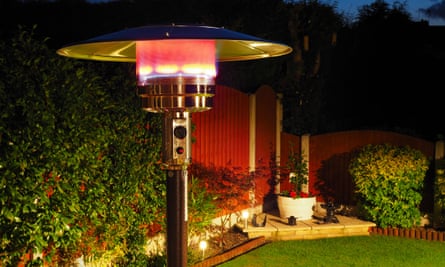Sales of patio heaters in the UK are rising: Homebase has nearly sold out and sales on eBay have soared. Mensa Heating UK recently sold 750 infrared heaters in one day. But what about the environmental impact of patio heaters? In Germany, the federal government is offering subsidies to hospitality businesses wishing to buy them, even though they had been banned in some cities, while the French ecology minister has called them an “ecological aberration” and announced a ban from next year. So what is the best way to relax outside and stay warm?
Is it OK to buy a patio heater?
The idea of using energy to heat outside air in an era of global heating is counterintuitive and, for many people, will rule out all garden heaters. “Heating up the outside is inherently wasteful of energy,” says Tim Hunt, director of Ethical Consumer. However, if you still believe the toll of being stuck indoors is too great, but you cannot survive outside without a heater, some cause less harm to the environment than others.

Which heaters are least damaging to the environment?
Electric heaters are less damaging than gas heaters. Whereas 40% of the heat from a gas heater goes straight up into the air, electric infrared models aim heat at the people who use them. Mensa Heating UK, for instance, claims to make “eco-friendly” heaters. Its chief executive, Irma Stevens, says: “An 11kg gas bottle, which could be used in a day, will send 32.23kg of CO2 into our atmosphere.” Infrared heaters, she claims, are “89% more efficient and less polluting than gas”. They are waterproof, and can be used inside a gazebo.
To enhance energy efficiency, choose a short-wave infrared lamp over a medium-wave one, says Stephen Levy, who founded Heat Outdoors about 12 years ago, around the time that indoor smoking bans were introduced in the UK. He advises that a “good parabolic reflector” will increase the heater’s output without using extra energy, as will asking visitors to wear dark colours; nothing reflects heat more than a shiny white puffer jacket. One infrared heater can warm four people seated at a rectangular table, or six at a circular table. “If you use green energy, the environmental cost is zero,” Levy says. However, as Hunt points out: “There are built-in carbon emissions to the manufacture of the heater, and then there is the electricity network infrastructure, which is also going to have a carbon cost.” Biofuels are another fraught issue. “Their use is, in many cases, proving to be entirely unsustainable,” says Hunt. Some have been found to more polluting that fossil fuels.
I have a green tariff, so will my electric heater be more eco-friendly?
Brian Horne, a senior insight and analytics consultant at Energy Saving Trust, says not. “The green tariff makes no difference to the environmental impact of a heater. We are all using the same electric grid.” Green tariffs, in which electricity suppliers buy renewable energy to match some or all of the electricity you use, send out an important political message and, over time, may stimulate the growth of the renewables market, but, says Horne: “The impact of turning on an electric appliance is the same whoever you are and wherever you are.” We all use a mixture of renewable and non-renewable energy and any electric heater will use whatever the grid supplies.

What if I switch off my indoor heating to compensate?
If you really cannot do without an outdoor heater, you could think about reducing your use of electricity elsewhere and use the outdoor heater selectively. “Outdoor heating might occasionally be necessary for older people with poorer circulation, or in particularly cold parts of the country,” concedes Hunt. “There is a small carbon budget for everyone that is consistent with the Paris climate agreement. If outdoor heating use is within this, perhaps due to driving less, or other reductions taken elsewhere, then there may be a place for it in your overall carbon usage mix.”
So you could tell yourself that you will offset the electricity used by your outdoor heater with other personal reductions, but, as Horne says: “Most people who care about the environment are already doing that.”
Are fire pits and chimineas good options?
Neither a traditional fire pit nor a chiminea will warm you in the way a heater will. Although Levy does sell these, he calls them “toys” and says they tend to make everyone smell of smoke. If the charcoal or wood you are burning is truly sustainable, you will not be contributing to net CO2 emissions. However, as Horne says, the greater threat from wood and coal burners is the release of fine particulate matter, known as PM2.5, into the air, particularly in urban areas where pollution levels are already high. PM2.5 has been linked to serious threats to health, including heart attacks, strokes and cancer. The UK government’s Clean Air Strategy, published in January 2019, calculated that burning solid fuels at home accounts for 38% of national PM emissions. A stove with a filter (such as the ones by Urban Fires) will emit fewer particulates, as will burning dry rather than wet matter. While charcoal and wood-burners seem like a “natural” choice, fitting in with the idea of a simple life, are they really in sympathy with the environment? Horne is clear on this: “If you live in a city, you have to go for an infrared. If you live in an area with no air-quality issues, you might opt for a chiminea. The only truly environmental option is not to buy [a heater] at all.”

How else can I keep warm?
Rebecca Newsom, head of politics at Greenpeace, says: “The ideal technology for keeping warm outdoors without heating the entire atmosphere is still a jumper.” There are a few other options. You could put up a windbreak, awning or gazebo to try to limit wind chill. In terms of clothing, you could invest in a good base layer in merino, bamboo or recycled yarn, wear two pairs of socks and liners inside your gloves, and dress head to toe for the climate where you live. Invest in a recycled insulated camping blanket, such as the ones from Rumpl or Voited, or unzip a sleeping bag and use it as a comforter. Make a flask. Wrap your hands around a hot mug. Layer up until you can barely move. Dig out your old hot-water bottle, or if you don’t have one, treat yourself to a recyclable model; Hugo Frosch has one made from 80% renewable materials. While disposable hand warmers are never a good environmental choice, there are rechargeable or reusable wheat-filled versions you can stuff in a pocket or slip inside the liners inside your gloves. Give it a try. If the cold is really unbearable, next time suggest a walk.
from Lifestyle | The Guardian https://ift.tt/35CpP14
via IFTTT

comment 0 Comment
more_vert